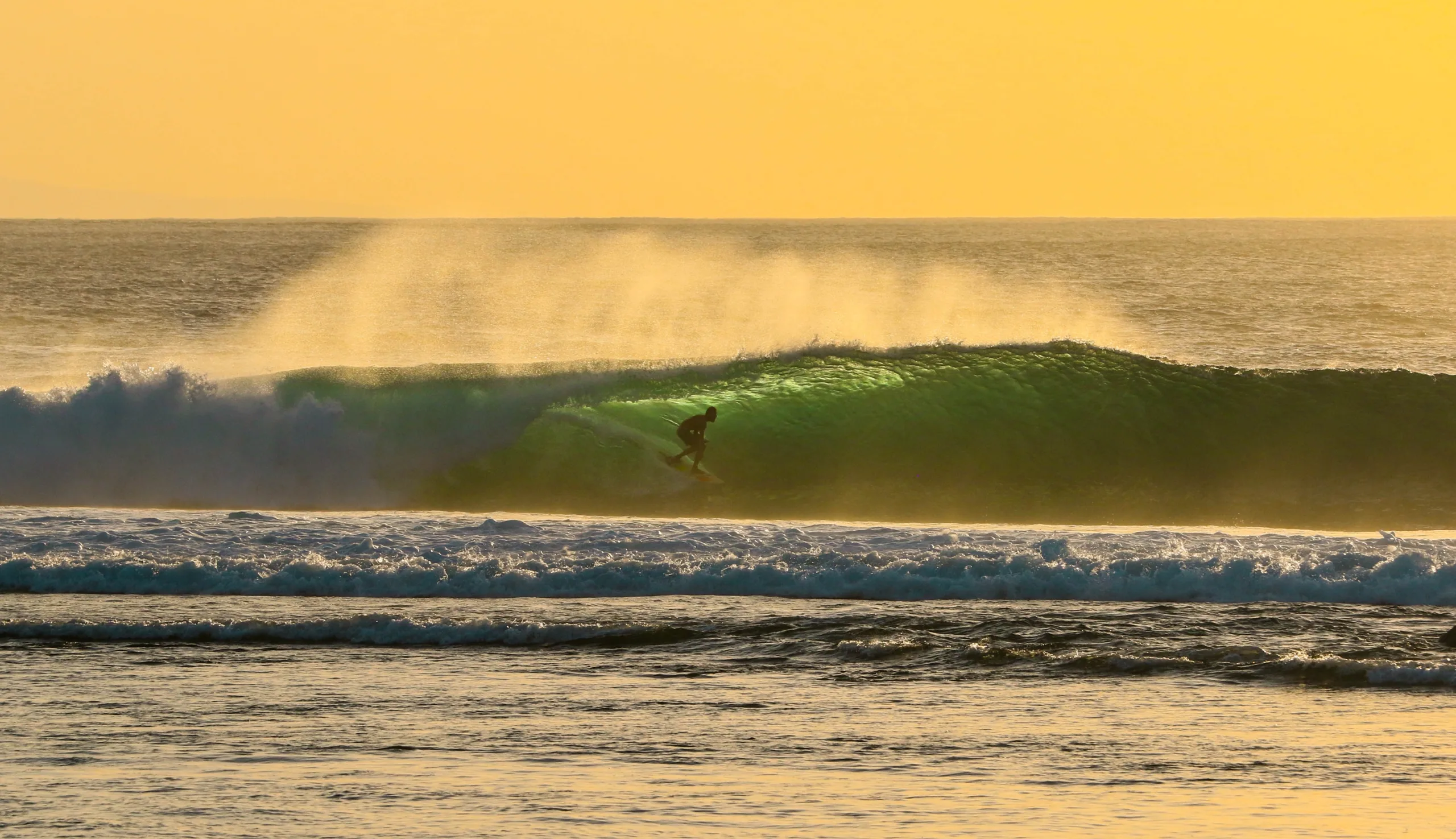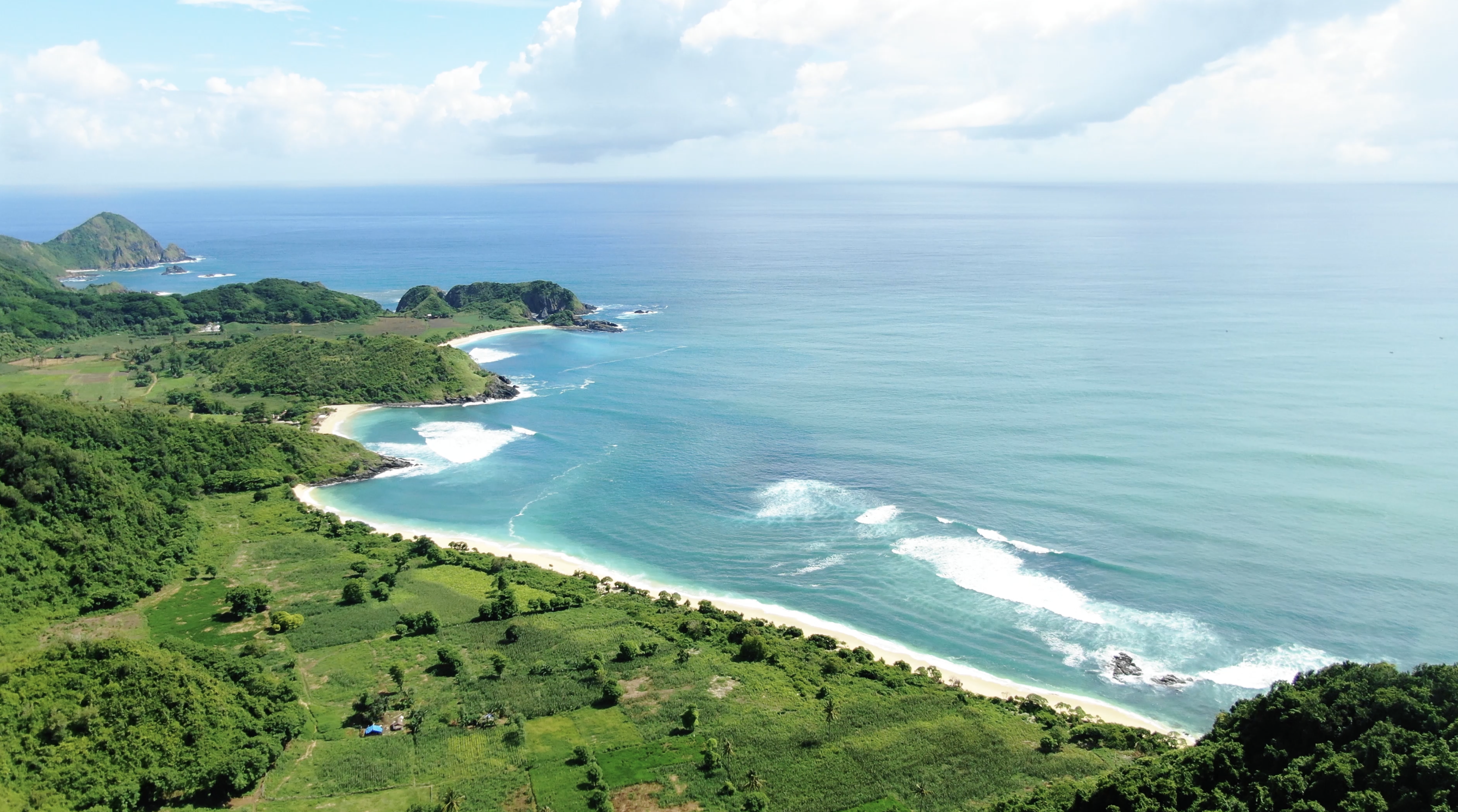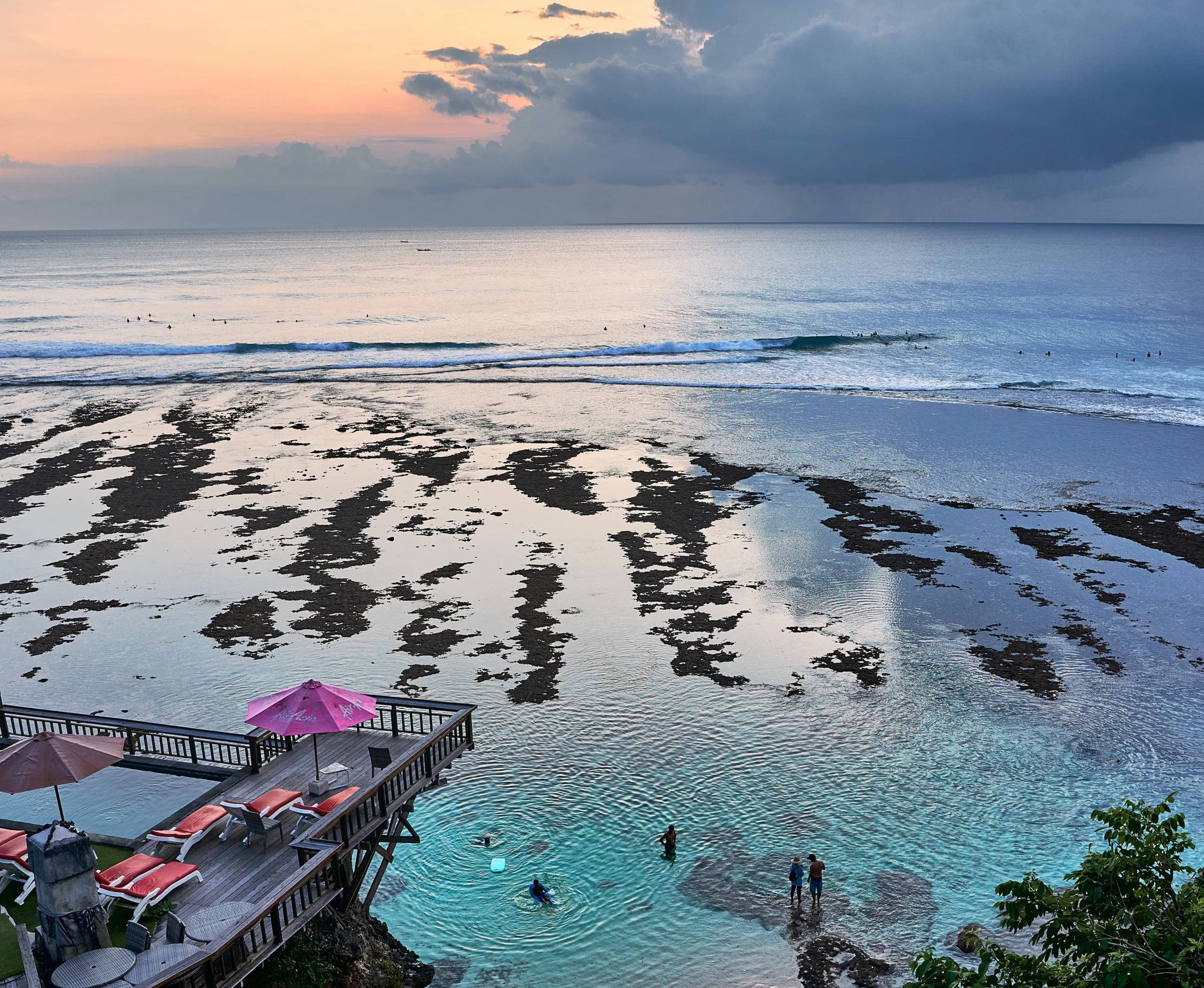As a world-class surfing destination, Indonesia needs no introduction. An archipelago primed to receive Indian Ocean swells year round and with perfectly formed coral reefs to bend those swells into every variation on the perfect reef break possible, there are more waves in Indonesia than you could ever hope to surf in one lifetime. In this post, we look at an overview of surfing in Indonesia, from where to surf, how to get around, and tips for surfing in what is “ground-zero” for perfect surf.
Table of Contents

Best Time of Year
The best time of year to surf in Indonesia is between April and October. This is considered the dry season in Indo and when the largest Indian Ocean swells happen. At this time of year, Indo is also greeted with trade winds, which means that many top breaks have offshore winds most of the time. However, in the wet season (October – April) there’s always something to surf, just expect more rain and afternoon onshores.
Best Surf Spots in Indonesia
Bali
Bali has long been the go-to surf destination in Indonesia. It’s where famous waves like Uluwatu put Balinese and Indonesian surfing on the map. An incredible island, with incredible waves. Uluwatu is the most famous Balinese surf spot, perched at the southwestern tip of the island, offering barrels and turn sections daily. But on the biggest days, the place transforms -into a big wave outer-reef. For more information on surfing in Bali–read the full guide.
Canggu is the next most popular surf spot in Bali and has two main spots. Echo Beach is the go-to for advanced surfers, a stretch of coast with three waves within it. A punchy hollow left, a beach break in the middle, and a right-hander on the other side.
If you’re a beginner or intermediate surfer in Canggu, head to Old Mans– a super mellow reef break with long rolling whitewater, epic for learners. Read my full guide on surfing in Canggu here. Elsewhere, check out islands such as Nusa Lembongan, for beautiful clear waters, fun waves, and a (slightly) more laid-back atmosphere.
Sumbawa
West Sumbawa
West Sumbawa is an incredibly wave-rich region, a consistent and powerful region, with some of the best waves in the world. The most famous and user-friendly is Yo-Yos, you’ve seen the videos, right? Jordy laying huge carves with a magnificent limestone backdrop! Yo-yo’s is a ridiculously fun right, for high-performance surfing. Elsewhere, you’ve got Supersuck, and Scar Reef, two freight train lefthanders, where if you can brave the shallow razor-sharp coral, you might score the best waves of your life.
Lakey Peak
Over on the other side of Sumbawa, you’ve got Lakey Peak. Oh, Lakey, what a place. With 5-6 world-class waves within walking distance, if you’re looking for somewhere to surf and do nothing else, Lakey’s is for you. The Peak is as perfect an a-frame as you could ever hope to surf, whereas on one side of the channel is Lakey Pipe, which speaks for itself. On the opposite side, is Nungas, a long wally lefthander, then just a few minutes by moped, you’ve got Cobblestones and Periscopes, two world-class right-handers with sections for tubes and turns.
Lombok
Desert Point
Desert Point is one of the best waves on Earth. A stupidly long freight train barrel, where if you’re an avid tube rider, you can ride the longest barrel of your life. It’s powerful and shallow and if you’ve got the balls, you can pack the end section known as the grower. A locked and loaded tube that keeps you in, growing and growing and getting throatier and heavier as it spins over a crazy shallow reef.
Kuta Lombok
If you’re a beginner or intermediate, Kuta Lombok is a wicked place to check out. With dozens of waves in the vicinity, there’s a little something for everyone here. Most of the waves are mellow reef breaks, lefts, rights, and easy to surf. If you’re after somewhere to introduce yourself to surfing lineups and get some reef break predictability, this one is for you. Read my full breakdown on surfing in Kuta Lombok here.

Java
G-Land
G-Land is another wave, that is famous and so steeped in Indonesian surf history and mysticism, it’s one of those dream waves. A long, powerful, freight train elf barrel with multiple sections. There are some intricacies that make it tick, but on large swell sin dry season, another place you can score the best wave of your life.
Sumatra
Krui
Krui is a crazily wave-rich region in South Sumatra. While it’s a mission to get to, put the effort in and you’ll be rewarded with every type of wave you could hope to surf, with minimal crowds. A-frame peaks, left points, slabs, and hollow beach breaks. There are just so many waves here, you’ll always have something to surf.
Mentawai
The Mentawai is ground zero for perfect waves as the island chain in North Sumatra has the highest concentration of world-class breaks one arth. Waves like Lances Right, Greenbush, Macaronis, PitStops, and Kandui, are epic waves. It’s truly paradise in this part of the world, with crystal clear blue waters, warmth, palms, beaches, and a wave for everyone. Read my full breakdown of surfing in the Mentawais here.
Nias
Nias is arguably the best right-hander in Indo. I mean, we’ve all seen those photos of thick dark green tubes. And while this doesn’t happen on the biggest Indian Ocean swells, on any given day, you’ve got wally high performance right as well as a handful of other fun waves in the area.
Getting Around
Flights
For exploring the furthest reaches of the Indonesian archipelago, flying is the best way to explore. Indo is huge and flying between the main islands is the only way to get around. You can hop on cheap domestic flights between most cities throughout the country. Check out Kayak for the cheapest prices. To know exactly how much taking surfboards on these Indonesian flights will cost, check out my full surfboard baggage fees for Indonesian airlines here.
Mopeds
Once you’re set up in any given Indonesian surf destination, mopeds are the go-to method of transportation. Whether you’re driving between surf breaks, or going between restaurants and your hotel, you’ll usually need a moped. Thankfully, you can rent a moped in most places in Indo for around $5 per day.
Car
I would only recommend this if you’re comfortable driving on the roads in Indo and for longer distances. For example, driving in Sumatra. But for more crowded places such as Bali, I’d avoid driving altogether just because of the traffic. If you’re looking for cheap hire cars in Bali, check out Discover Cars.
Taxis
Taxis are common in Indonesia, and if you’re moving between surf towns, I’d suggest using taxis. This way, you can put all your bags and surfboards in or on the taxi and let someone else take care of the driving. (a local driver better versed in navigating the roads and traffic), then rent a moped at said destination.
Ferry
For journeys between smaller islands, ferries are a super affordable and easy way to get around in Indo. For instance, you can get between Bali and Lombok for around $30 and Nusa Lembongan/Bali for $15. While not the most comfortable means of transport, it’s cheap and a good way to move between islands on a budget surf trip.
Where to Stay?
Hostels
If you’re on a budget surf trip to Indonesia, hostels are your best friend. Thankfully, Indonesia is one of the world’s cheapest surf destinations, and staying at one of the many hostels in the main surf towns will give you a shared room for $10 per night or less. Book the cheapest hostels in Indonesia on Hostelworld.com
Privates
If you prefer your room while traveling (like me), check out Booking.com. You can find epic (clean and comfortable) private rooms for between $10-20 per night. I always look for places with daily/weekly cleaning, great wifi, good reviews, and under $20 per night.
Enjoying this post? For more information on surfing in Indonesia, check out my YouTube channel, there is heaps of Indo content on there, giving you all, the info you need to visit and surf in Bali, The Mentawais, and Lombok.
Surf Camps
If you’d prefer your Indonesian surf trip all wrapped into one easy package, check out Book Surf Camps. They offer surf camps in Indonesia for all abilities, and many packages include all your transfers, surf coaching, surf equipment, accommodation, and food – all in one easy booking. Check out the best Indonesian surf camps here.
Tips for Surfing in Indonesia
Language
In surf hotspots such as Bali and Kuta Lombok, most people speak English and you’ll get away without speaking Bahasa (Indonesian). However many smaller restaurants and local establishments, people don’t speak English and this only gets more so, when heading to more remote Indonesian surf spots. Just a few phrases of Bahasa can go a long way, not only in gaining some rapport with locals but increasing your interactions and making your travel easier.
Currency
Indonesia uses the Indonesian Rupiah as the currency and 100K IDR is around $ 5-6 USD. Most large surf towns have restaurants and places that will accept cards, but smaller places are mainly cash, so it is always a good idea to have a bit of cash on you, whether it be to pay for taxis, petrol, or meals.
Culture
Indonesia is the largest Muslim population in the world and Islam is prominent across most of the country. The only exception is Bali– a predominantly Hindu island. Hinduism is a huge part of local culture here and you’ll see many festivals and daily practices taking place across the island. The most common is the “Canang Saris”, which are offerings to the gods, you’ll see these placed on the road and in shrines every morning.

Indonesia Country Information
- Currency: IDR
- Language: Indonesian
- Time Zone: GMT + 8
- Visa: 1 Month VOA
- Vaccine: Not Required
Final Words
There’s just nowhere better, for cheap living, world-class waves, and good times, there is nowhere better than Indonesia. For more information on surfing in Indonesia, check out my other guides such as Canggu, Kuta Lombok, and The Mentawais. Or check out my YouTube channel for more detailed breakdowns. Any questions, please comment below.
